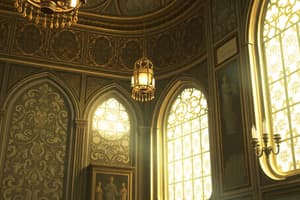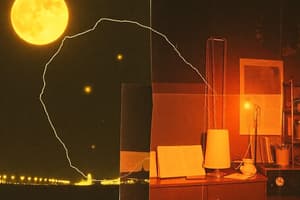Podcast
Questions and Answers
How do incandescent lights produce light?
How do incandescent lights produce light?
- By heating a filament until it glows (correct)
- By emitting light due to an electric discharge
- By converting electrical energy directly into light
- By exciting a gas inside the tube
Why have incandescent lights been widely replaced with more energy-efficient options?
Why have incandescent lights been widely replaced with more energy-efficient options?
- Because of their high energy consumption (correct)
- For their quick response time in turning on
- Because they emit ultraviolet light harmful to human eyes
- Due to their ability to last longer than other light sources
How do fluorescent lights operate to produce light?
How do fluorescent lights operate to produce light?
- By converting electrical energy directly into light
- By heating a filament until it glows
- By exciting a gas inside the tube (correct)
- By emitting light due to an electric discharge
What is a key characteristic of LED technology in the lighting industry?
What is a key characteristic of LED technology in the lighting industry?
Why are fluorescent lights often used in commercial and industrial settings?
Why are fluorescent lights often used in commercial and industrial settings?
Which type of light source has revolutionized the lighting industry?
Which type of light source has revolutionized the lighting industry?
How do High-Intensity Discharge (HID) lamps work?
How do High-Intensity Discharge (HID) lamps work?
Where are High-Intensity Discharge (HID) lamps commonly used?
Where are High-Intensity Discharge (HID) lamps commonly used?
What is the main advantage of Fiber Optic Lights?
What is the main advantage of Fiber Optic Lights?
Which type of light source would be best suited for artistic installations?
Which type of light source would be best suited for artistic installations?
Why are High-Intensity Discharge (HID) lamps ideal for large-scale outdoor applications?
Why are High-Intensity Discharge (HID) lamps ideal for large-scale outdoor applications?
What distinguishes Fiber Optic Lights from traditional light sources in terms of light transmission?
What distinguishes Fiber Optic Lights from traditional light sources in terms of light transmission?
Flashcards are hidden until you start studying
Study Notes
Light Sources
Light is an essential aspect of our daily lives, providing illumination in our homes, offices, streets, and public spaces. It is used to create displays on electronic devices, enable photography, and even guide our nighttime activities. This section will discuss various types of light sources and their uses.
Incandescent Lights
Incandescent lights produce light by heating a filament until it glows, producing visible light. These bulbs have been widely replaced with more energy-efficient options due to high energy consumption. However, they are still found in some applications due to their warm white glow, which mimics natural light.
Fluorescent Lights
Fluorescent lights operate through an electric discharge that excites a gas inside the tube, causing a phosphor coating on the inside surface to emit light. The bulbs can last longer than incandescents but consume less power because only a small amount of electricity is required to maintain the electric discharge. They are often used in commercial and industrial settings for general lighting requirements.
LED Lights
LED (Light Emitting Diode) technology has revolutionized the lighting industry. These solid-state lighting systems rely on semiconductor materials that convert electrical energy directly into light. LEDs come in various shapes and sizes, including bulbs, strips, panels, and specialized designs like solar-powered or battery-operated versions. Their efficiency and longevity make them ideal replacements for traditional light sources across residential, commercial, and outdoor environments.
High-Intensity Discharge (HID) Lamps
HID lamps work by passing electricity through a gas within the lamp, creating ultraviolet light that interacts with a phosphor, resulting in visible light. Examples include mercury vapor, metal halide, sodium, and high-pressure sodium lamps. HIDs are commonly used for large-scale outdoor lighting applications such as streetlights, parking lots, and stadiums due to their brightness and energy efficiency.
Fiber Optic Lights
Fiber optic lights transmit light along optical fibers, using total internal reflection to carry light between two points without any loss of light intensity. This makes them suitable for applications where light needs to be transmitted over long distances while maintaining its original quality. Fiber optic lighting is often used in architectural and artistic installations, medical procedures, and signaling systems.
Studying That Suits You
Use AI to generate personalized quizzes and flashcards to suit your learning preferences.




